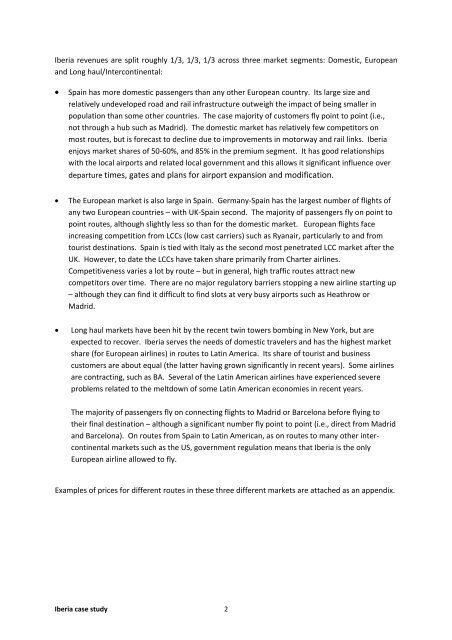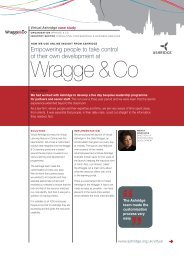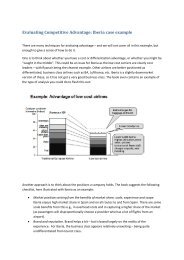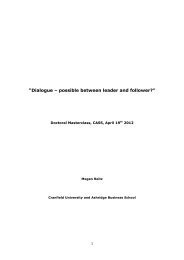IBERIA CASE STUDY - Ashridge
IBERIA CASE STUDY - Ashridge
IBERIA CASE STUDY - Ashridge
You also want an ePaper? Increase the reach of your titles
YUMPU automatically turns print PDFs into web optimized ePapers that Google loves.
Iberia revenues are split roughly 1/3, 1/3, 1/3 across three market segments: Domestic, European<br />
and Long haul/Intercontinental:<br />
• Spain has more domestic passengers than any other European country. Its large size and<br />
relatively undeveloped road and rail infrastructure outweigh the impact of being smaller in<br />
population than some other countries. The case majority of customers fly point to point (i.e.,<br />
not through a hub such as Madrid). The domestic market has relatively few competitors on<br />
most routes, but is forecast to decline due to improvements in motorway and rail links. Iberia<br />
enjoys market shares of 50‐60%, and 85% in the premium segment. It has good relationships<br />
with the local airports and related local government and this allows it significant influence over<br />
departure times, gates and plans for airport expansion and modification.<br />
• The European market is also large in Spain. Germany‐Spain has the largest number of flights of<br />
any two European countries – with UK‐Spain second. The majority of passengers fly on point to<br />
point routes, although slightly less so than for the domestic market. European flights face<br />
increasing competition from LCCs (low cast carriers) such as Ryanair, particularly to and from<br />
tourist destinations. Spain is tied with Italy as the second most penetrated LCC market after the<br />
UK. However, to date the LCCs have taken share primarily from Charter airlines.<br />
Competitiveness varies a lot by route – but in general, high traffic routes attract new<br />
competitors over time. There are no major regulatory barriers stopping a new airline starting up<br />
– although they can find it difficult to find slots at very busy airports such as Heathrow or<br />
Madrid.<br />
• Long haul markets have been hit by the recent twin towers bombing in New York, but are<br />
expected to recover. Iberia serves the needs of domestic travelers and has the highest market<br />
share (for European airlines) in routes to Latin America. Its share of tourist and business<br />
customers are about equal (the latter having grown significantly in recent years). Some airlines<br />
are contracting, such as BA. Several of the Latin American airlines have experienced severe<br />
problems related to the meltdown of some Latin American economies in recent years.<br />
The majority of passengers fly on connecting flights to Madrid or Barcelona before flying to<br />
their final destination – although a significant number fly point to point (i.e., direct from Madrid<br />
and Barcelona). On routes from Spain to Latin American, as on routes to many other inter‐<br />
continental markets such as the US, government regulation means that Iberia is the only<br />
European airline allowed to fly.<br />
Examples of prices for different routes in these three different markets are attached as an appendix.<br />
Iberia case study 2














